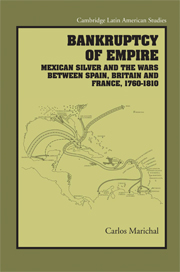Book contents
- Frontmatter
- Contents
- List of Tables and Figures
- Acknowledgements
- Introduction
- 1 Resurgence of the Spanish Empire: Bourbon Mexico as Submetropolis, 1763–1800
- 2 An Imperial Tax State: The Fiscal Rigors of Colonialism
- 3 Imperial Wars and Loans from New Spain, 1780–1800
- 4 The Royal Church and the Finances of the Viceroyalty
- 5 Napoleon and Mexican Silver, 1805–1808
- 6 Between Spain and America: The Royal Treasury and the Gordon & Murphy Consortium, 1806–1808
- 7 Mexican Silver for the Cortes of Cádiz and the War against Napoleon, 1808–1811
- 8 The Rebellion of 1810, Colonial Debts, and Bankruptcy of New Spain
- Conclusions: The Financial Collapse of Viceroyalty and Monarchy
- Appendixes
- Bibliography
- Index
- CAMBRIDGE LATIN AMERICAN STUDIES
1 - Resurgence of the Spanish Empire: Bourbon Mexico as Submetropolis, 1763–1800
Published online by Cambridge University Press: 14 July 2009
- Frontmatter
- Contents
- List of Tables and Figures
- Acknowledgements
- Introduction
- 1 Resurgence of the Spanish Empire: Bourbon Mexico as Submetropolis, 1763–1800
- 2 An Imperial Tax State: The Fiscal Rigors of Colonialism
- 3 Imperial Wars and Loans from New Spain, 1780–1800
- 4 The Royal Church and the Finances of the Viceroyalty
- 5 Napoleon and Mexican Silver, 1805–1808
- 6 Between Spain and America: The Royal Treasury and the Gordon & Murphy Consortium, 1806–1808
- 7 Mexican Silver for the Cortes of Cádiz and the War against Napoleon, 1808–1811
- 8 The Rebellion of 1810, Colonial Debts, and Bankruptcy of New Spain
- Conclusions: The Financial Collapse of Viceroyalty and Monarchy
- Appendixes
- Bibliography
- Index
- CAMBRIDGE LATIN AMERICAN STUDIES
Summary
When the great explorer and scientist Alexander von Humboldt visited colonial Mexico in 1803, he was witness to one of the final and most brilliant periods in the history of the viceroyalty. Eloquent proof could be found in the capital of Mexico which, with its more than 100,000 inhabitants, was the largest city in the western hemisphere. It was also one of the most prosperous to be judged by its many magnificent palaces, by the display of luxurious carriages along its broad avenues, by the great number of mercantile establishments, and by the activity of its popular markets. The heart of political, financial, and social life revolved around the royal palace, cathedral, and stores in the main square known as the zocalo. In the palace were the grand offices of the viceroy of New Spain and of many high-level functionaries, and there they received the members of the privileged corporations of colonial society: the ancient and venerable merchant guild, the miner's association, the great landowners, the church prelates, and military officers. But in late afternoons and evenings, the palace was also seat to a number of social events, including games of gambling.
Behind the royal palace, there was a large building with patio which also had enormous economic and political importance: the royal mint. In his classic work, Political Essay on the Kingdom of New Spain, Humboldt noted that it was the greatest and richest mint in the world, and added:
It is impossible to visit this building …
- Type
- Chapter
- Information
- Bankruptcy of EmpireMexican Silver and the Wars Between Spain, Britain and France, 1760–1810, pp. 16 - 47Publisher: Cambridge University PressPrint publication year: 2007

